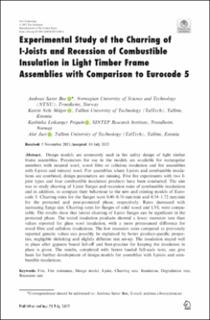| dc.contributor.author | Bøe, Andreas Sæter | |
| dc.contributor.author | Mäger, Katrin Nele | |
| dc.contributor.author | Friquin, Kathinka Leikanger | |
| dc.contributor.author | Just, Alar | |
| dc.date.accessioned | 2023-08-25T07:33:37Z | |
| dc.date.available | 2023-08-25T07:33:37Z | |
| dc.date.created | 2023-08-07T13:31:37Z | |
| dc.date.issued | 2023 | |
| dc.identifier.issn | 0015-2684 | |
| dc.identifier.uri | https://hdl.handle.net/11250/3085727 | |
| dc.description.abstract | Design models are commonly used in fire safety design of light timber frame assemblies. Parameters for use in the models are available for rectangular members with mineral wool, wood fibre or cellulose insulation and for assemblies with I-joists and mineral wool. For assemblies where I-joists and combustible insulations are combined, design parameters are missing. Five fire experiments with two Ijoist types and four combustible insulation products have been conducted. The aim was to study charring of I-joist flanges and recession rates of combustible insulations and in addition, to compare their behaviour to the new and existing models of Eurocode 5. Charring rates for the flanges were 0.40–0.76 mm/min and 0.54–1.72 mm/min for the protected and post-protected phase, respectively. Rates decreased with increasing flange size. Charring rates for flanges of solid wood and LVL were comparable. The results show that lateral charring of I-joist flanges can be significant in the protected phase. The tested insulation products showed a lower recession rate than values reported for glass wool insulation, with a more pronounced difference for wood fibre and cellulose insulations. The low recession rates compared to previously reported generic values can possibly be explained by better product-specific properties, negligible shrinking and slightly different test set-up. The insulation stayed well in place after gypsum board fall-off and best-practice for keeping the insulation in place is given. The results, completed with future loaded full-scale tests, can give basis for further development of design models for assemblies with I-joists and combustible insulations. | en_US |
| dc.language.iso | eng | en_US |
| dc.publisher | Springer | en_US |
| dc.rights | Navngivelse 4.0 Internasjonal | * |
| dc.rights.uri | http://creativecommons.org/licenses/by/4.0/deed.no | * |
| dc.subject | Fire | en_US |
| dc.subject | Fire resistance | en_US |
| dc.subject | Design model | en_US |
| dc.subject | I-joist | en_US |
| dc.subject | Charring rate | en_US |
| dc.subject | Insulation | en_US |
| dc.subject | Degradation rate | en_US |
| dc.subject | Recession rate | en_US |
| dc.title | Experimental Study of the Charring of I-Joists and Recession of Combustible Insulation in Light Timber Frame Assemblies with Comparison to Eurocode 5 | en_US |
| dc.title.alternative | Experimental Study of the Charring of I-Joists and Recession of Combustible Insulation in Light Timber Frame Assemblies with Comparison to Eurocode 5 | en_US |
| dc.type | Peer reviewed | en_US |
| dc.type | Journal article | en_US |
| dc.description.version | publishedVersion | en_US |
| dc.rights.holder | © 2023 The authors | en_US |
| dc.subject.nsi | VDP::Teknologi: 500 | en_US |
| dc.source.journal | Fire technology | en_US |
| dc.identifier.doi | 10.1007/s10694-023-01464-x | |
| dc.identifier.cristin | 2165306 | |
| dc.relation.project | Norges forskningsråd: 294649 | en_US |
| cristin.ispublished | true | |
| cristin.fulltext | original | |
| cristin.qualitycode | 1 | |

